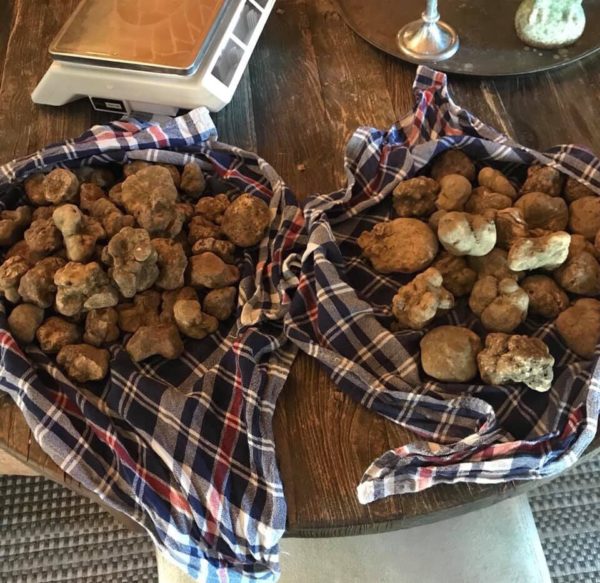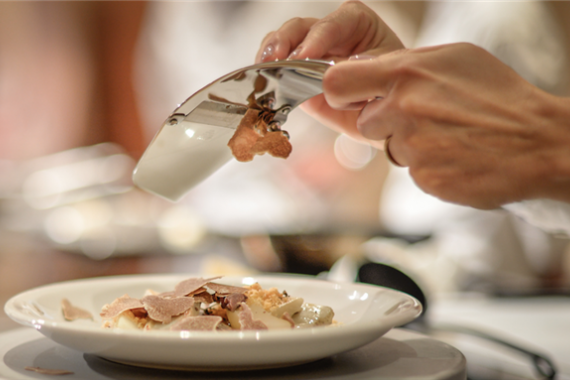On the surface, people who sell white truffles to restaurants aren’t quite the merchants of luxury one might expect. No Rolex watches, no Cartier jewelry. They fly under the radar like undercover cops or the neighborhood weed dealer. It isn’t unusual to see them dressed down, in sports caps and hoodies, nonchalantly wheeling around their nuggets of buried treasure in carry-on luggage like doe-eyed tourists who fly Spirit Airlines.
Their contraband is meticulously sealed in airtight containers to ensure no truffle aromas might seep out and blow their cover. When you’re shlepping around tens of thousands of dollars of rare earth candy, it’s unwise to make a spectacle of yourself. Unlike most business deals between chefs and their purveyors, the anonymous exchange of truffles for money is shady af.
Oddly, it’s difficult to authenticate the provenance of truffles, which adds to their mystique. Even though you’d expect that chefs would insist on buying the genuine article, the truffle industry lacks a proper ombudsman in the way that consortiums govern Italian wine production with A.O.C designations or Italian cheeses are assigned to a specific D.O.P. Truffles trade on trust.
This means there is always a chance that you’re being sold truffles advertised as from Alba that are actually from Slovenia or Istria, among the very few other places in the world that have soils conducive to unearthing these wild little tubers. White truffles cannot be cultivated. Nature decides for herself where they randomly spore, and she doesn’t make them easy to find.
Provenance aside, the most important reason you shouldn’t order them in a restaurant is freshness. Assuming you aren’t sitting over a bowl of fresh tagliatelle in a restaurant in Piedmont, the truffle you’re eating is likely well past its prime. While the importation of white truffles has become more efficient through the years, they’re still among the most highly perishable agricultural products. Even the most fastidiously preserved white truffle will have lost most of its potency within just a few days.

Chefs in upscale restaurant must front thousands of dollars to put truffles on their menus and sales can be very erratic and inconsistent. Unlike other products chefs would dispose of when spoilage is an issue, they’ll do anything possible to usurp old inventory of truffles before serving the freshest ones. They’ll never admit they do it, but they do. Chefs love serving truffles because they’re a profit machine that requires little effort. Buy them, shave them and overcharge.
Sommeliers in high-end restaurants face a similar predicament when opening expensive trophy bottles. If they perceive that certain wines may be slightly off or borderline, they may try to serve them anyway hoping that the guest will not object. Wholesale cost on an $800 bottle that was purchased by auction five years ago cannot be recouped.
All of this means that the truffles on your hundred dollar pasta dish are likely not the freshest ones the chef has in the kitchen. If the aroma is flat or newspapery, you’ve been suckered. Of course, all chefs aren’t guilty of compromising their standards. Unfortunately, it’s very difficult to know which kitchens are trustworthy and which aren’t.
The best way to avoid being served inferior truffles is to dine at restaurants that do more volume. The more they cycle through product, the fresher they’ll be. But it’s never guaranteed. Chefs prefer to buy larger quantities of truffles to get better pricing. That can lead to an unwanted surplus when sales lag behind expectations.
Beware the bait and switch. You might see sexy “show truffles” on display, filling the dining room with their musky smell but those will often not be the same ones the chef is shaving over your dish. Ask your servers if the truffle will be shaved table-side. If they say no, insist they do. Politely ask to smell the truffle beforehand. If its aroma is not potent when you smell it, its flavor wont be when they shave it over your food. Remember, generously covering a dish with shavings of an old truffle will only make it taste more like an old truffle.

